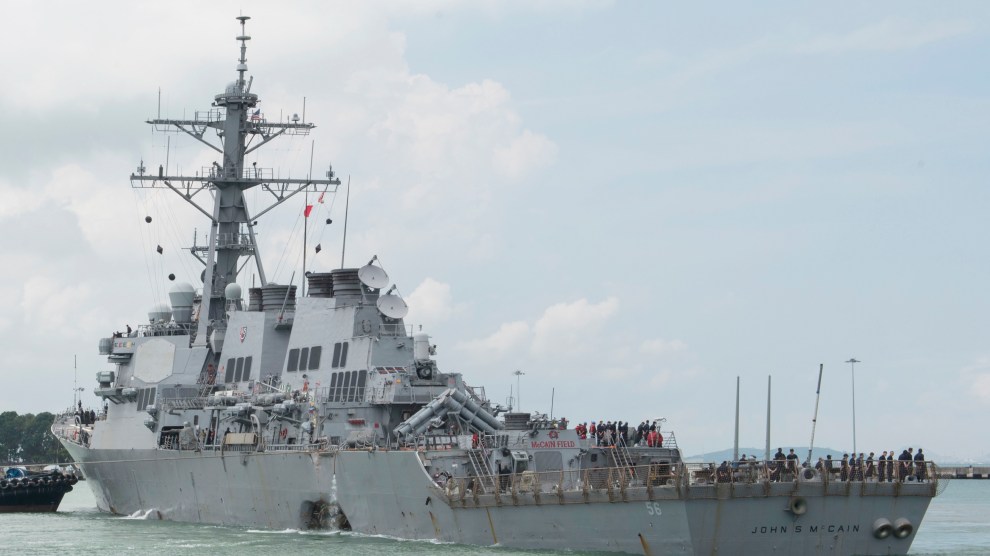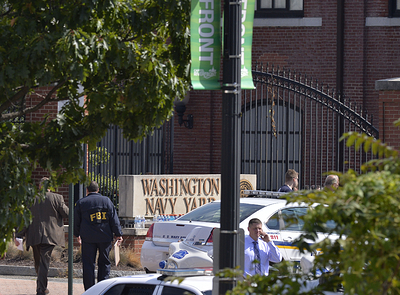
On Aug. 21, 2017, the guided-missile destroyer USS John S. McCain (DDG 56) steers towards Changi Naval Base in Singapore after a collision. Navy and Marine Corps divers will enter flooded compartments on the ship to search for 10 missing sailors.Joshua Fulton/AP
This story originally appeared on ProPublica.
After two of its destroyers were involved in deadly accidents in the summer of 2017, the Navy’s leaders pledged real change: more sailors for their ships, and better training for those sailors and the officers who led them. Old or broken equipment would be fixed, too. Most important, the Navy’s top command would stop forcing ships out to sea before they were ready.
In late 2017, as part of an effort to assure commanders that the Navy was committed to genuine reform, Adm. Philip Davidson embarked on a speaking tour. Davidson was in charge of “readiness”—responsible for making sure that the Navy’s ships were fully staffed, and that sailors were adequately trained and equipped and ready for combat. He had recently authored a public report laying out dozens of specific weaknesses that the Navy had begun fixing.
One of Davidson’s stops in November 2017 was in San Diego, and inside the base’s movie theater, he addressed hundreds of concerned commanders and officers. He was met with a series of tough questions, including a particularly sensitive one: If the commanders believed their ships were not ready, could they, as the Navy had promised, actually push back on orders to sail?
Davidson, according to an admiral inside the theater, responded with anger.
“If you can’t take your ships to sea and accomplish the mission with the resources you have,” he said, “then we’ll find someone who will.”
The response roiled the audience, and word of it quickly spread among Navy officers across the globe, according to interviews done by ProPublica. Many took it as a sign that the Navy as an institution had failed to heed the painful lessons of its worst disasters at sea in four decades. In June 2017, the USS Fitzgerald collided with a giant cargo ship in the Pacific and seven sailors died. Months later, the USS John S. McCain, another destroyer in the Navy’s heralded 7th Fleet, was struck by an oil tanker, and 10 more sailors were lost. The Navy’s investigations of the accidents in the Pacific showed that many of its sailors were poorly trained and worked to exhaustion.
One of the admirals in San Diego that day was Thomas Rowden. He had been among a number of senior Navy leaders who had warned that the 7th Fleet was vulnerable in the months before the 2017 crashes, and he’d been pushed out in their aftermath. To him, Davidson’s response meant the Navy remained willing to put its sailors at risk if that’s what it took to meet the demands of higher-ups.
Rowden, who recounted the San Diego meeting in an interview with ProPublica, said that if he was alarmed by Davidson’s presentation, he was impressed by those who had asked the hard questions.
“I was proud of them for their forthrightness,” he said, “and speaking truth to power.”
Davidson, who today is the top military commander in the Pacific, said through a spokesman that his remarks in San Diego might have been misinterpreted, and that he only meant to say that if ships were not fit to sail, they would be replaced by others that were. No one, he said, would be fired or replaced for responsibly raising safety concerns.
A ProPublica investigation this month reconstructed the fatal voyage of the Fitzgerald and revealed the years of warnings ignored by senior Navy officials before the collisions involving the Fitzgerald and the McCain. The stories described mistakes by the officers in command of the ships, but they also showed that senior Navy leaders had helped set the conditions for failure and ignored years of warnings. Ships in the 7th Fleet were not fully qualified for missions. They were lacking sailors with expertise in navigation. Radars were broken or operated incorrectly. Warship commanders faced unrelenting demands to conduct missions in the Pacific as North Korea, China and Russia emerged as growing threats.
The articles have prompted an outpouring of response from current and former Navy officials up and down the chain of command. Many, like those in the audience in San Diego, are worried the Navy remains vulnerable to deadly accidents. Indeed, interviews and an examination of the Navy’s publicly announced reforms raise doubts about whether senior leaders have fully delivered on their promises more than 18 months after the 7th Fleet disasters.
One officer said Navy leaders are misrepresenting how well-trained their crews are by temporarily loaning specialists from his destroyer to other ships just before their crews undergo testing. Ships that cannot meet new training and staffing goals are nonetheless granted special permission and sent to sea. Another officer said higher-ups had raided his destroyer for parts to ensure that other warships were ready to deploy.
Some sailors said the Navy’s reforms appear to have focused more on improving test scores on navigational skills and not on fixing real problems, like the inability to operate missile defense equipment.
“People are crossing their fingers and saying, ‘My God, I hope this works out,'” said the second in command of one Navy destroyer. The officer on the destroyer, like others interviewed for this article, requested anonymity for fear of reprisal. “Hope has become a course of action.”
A veteran sailor said he has seen crew members who are fearful of accidents and uncertain about how to operate radars and other critical equipment. On Feb. 5, 2019, two Navy ships collided off the coast of Florida during a training exercise, though there were no injuries.
“I don’t know what would happen if there was a major conflict,” the sailor said. “When your systems aren’t up or working, what really are you but a cruise ship?”
The 7th Fleet is the largest armada in the world and one of America’s most strategic military commands, central to containing China and defending against North Korean ballistic missiles. It has thus come under intense pressure in recent years to regularly demonstrate its might, conducting both secret missions and very public displays of force.
John Pendleton, one of the senior directors of the Government Accountability Office, the investigative arm of Congress, was one of many who had warned Navy leaders in the months and years before the crashes that the 7th Fleet’s ships were being run ragged: training was declining, crews were too small and ships were deteriorating. The Pentagon wrote to the GAO that the Navy was “well aware of the risks” and accepted them as the cost of increasing its presence in the region.
Now, even after the crashes underscored the consequences of those risks, Pendleton said he had lingering questions about the Navy’s commitment. Last fall, Pendleton went to inspect the operations of the 7th Fleet. He walked the decks of ships, talked to sailors and officers and interviewed the fleet’s commanders.
He said he was unnerved by some of the things he found. The Navy’s renewed focus on training was evident, he said. But sailors told him they were still fatigued from 100-hour work weeks. Several reported the Navy was playing “shell games” by shuffling sailors around to make it appear as though ships were fully manned. Maintaining aging, hard-driven ships was proving a stubborn problem.
“I’m concerned that under-manning is at the root of the Navy’s problems,” Pendleton said. “I’m not sure they will solve it any time soon.”
Senior Navy leaders are scheduled to publicly detail the status of their reform efforts at a hearing on Capitol Hill on Tuesday.
In their last appearance, after ProPublica published its investigation this month, Davidson defended the Navy by noting that the vast majority of ships were not crashing, a remark that drew widespread derision.
In an interview with ProPublica on Monday, Adm. Bill Moran, the Navy’s second in command, said the Navy has committed $1 billion to fixing the problems it has identified since the collisions.
Moran said the Navy has begun to work on 91 of 103 initiatives, such as providing more sailors to under-manned ships in Japan and stopping ships from sailing without complete certifications regarding their navigation and war-fighting abilities—both issues in the collisions of the Fitzgerald and the McCain in 2017.
But he acknowledged that the Navy has not, to date, completed any of the reforms. He said that because of the scope and complexity of the effort, it will take time to transform an institution the size of the Navy.
“We’ve learned some tough lessons from these mishaps. We’ve been doing everything we can to institutionalize these changes that we’ve identified,” he said.
Asked specifically about some of the claims made by sailors and officers interviewed by ProPublica, Moran said he had no reason to doubt them.
“It doesn’t happen overnight,” Moran said of the reforms.
For the past year, Moran has personally led the effort to implement the Navy’s reforms as co-chairman of the Readiness Reform and Oversight Council, along with the undersecretary of the Navy, Thomas B. Modly.
So far, Navy leaders say they’ve launched a new command in Japan that will ensure that ships get enough time for training and maintenance. They say they have increased the amount of training provided to officers to emphasize navigation. And they say they have deployed advanced simulators to help officers learn how to work with other sailors on a watch.
Moran produced charts showing that the new programs are beginning to have an effect. The Navy hadn’t filled 7,400 at sea slots in 2018. The number has now dropped to 6,200 unfilled positions. Ships in Japan had been sailing with well under 90 percent of their crew. Today, the ships have 100 percent, he said.
But some of the Navy’s pledged reforms are vague and lack clear measures to gauge success. One proposed change calls for the Navy to “create a forward-looking learning culture built upon systemic data analyses.” That’s supposed to start in September. Another seeks to “ensure Navy leaders are fully aware of the consequences of their decisions regarding near and long-term readiness and operations.” The start date is “TBD”—to be determined.
Other reforms have proven less than fully effective. In September, the Navy announced a new system to track the hours that officers spend standing watch, similar to how pilots track their time in the cockpit.
The Navy said it intended to use the new data to analyze trends among officers’ experiences in standing watch. Instead, it provided officers with bound notebooks in which they could keep track of their time by hand.
The information isn’t entered into a centralized database or used by Navy leaders to better understand whether officers are spending enough time standing watch on ship bridges or combat rooms.
“These are low-tech, high-honor-system records,” said another executive officer of a U.S.-based ship. “They have fixed the wrong thing.”
Moran agreed that more needed to be done: We “need to be entering this into a database and analyzing it,” he said. “We’re going to get after that,” he added.
The officer on the U.S.-based ship said the Navy had also pledged to create a system to track near-misses at sea. The Fitzgerald had been involved in three such incidents in the weeks before its collision. But the system, he said, involved writing up an incident in a Word document and sending it up the chain of command. While a senior commander reviews such reports on an individual basis, no larger analysis of the data is done, the officer said. The officer spoke anonymously because he, too, feared being punished for his candor.
Moran said he wasn’t aware of that practice but called it a “fair” critique, if true. “It speaks to the difference between implementation and completion,” he said.
The officer said his ship, currently undergoing lengthy repairs, had been cannibalized for nearly 20 different parts, including an antenna and a throttle control, to outfit other ships headed for sea duty. In turn, he expected to take parts from other ships before he deployed. The Navy has 288 combat ships.
While such “rolling cannibalizations” are supposed to be done sparingly, the officer said they were routinely approved by his commanders.
“I don’t think we’ve adequately learned as an institution,” the officer said. “The seeds are all there for [accidents] to happen again.”
Moran said cannibalizations have existed as long as the Navy, but he acknowledged that they are generally undesirable, occurring when parts are not available. To improve, the Navy is streamlining maintenance, even sending out 3D printers to manufacture some parts, he said.
The lack of trained personnel was a recurring theme that contributed to both crashes. The Fitzgerald had set sail with about 270 sailors, well below the 303 called for by the Navy.
One of the officers interviewed by ProPublica in recent weeks said senior commanders routinely provided waivers for ships whose commanders reported being unable to meet standards due to a lack of skilled sailors.
“Even the newest ships, we are getting waivers all over the place for manning,” the executive officer said. “All that matters is paperwork. That’s all that matters.”
The situation is reminiscent of the Navy’s practice of approving waivers for ships in the 7th Fleet to be sent out on missions without being fully certified to conduct navigation and warfare operations. The Navy canceled all such waivers in the aftermath of the crashes.
“We have to be honest,” the executive officer said. “We can’t go before Congress and say, ‘Yup, we’re good to go.'”
He said many of the conditions detailed in ProPublica’s stories remain unchanged. On his ship, he said, sailors might average about five hours of sleep per night, and sometimes get no sleep at all. He described commanders who are afraid of making mistakes and afraid to say no to orders to get underway, even with too few sailors or dodgy equipment, for fear of being fired. They are being pushed to a pace, he said, that is at “the lunatic fringe of unsafe.”
The captain doesn’t even get five hours of sleep, the officer said: “His phone is ringing off the hook because we are so sensitive right now to anything happening. By day No. 2, he’s a zombie.”
And he said he and some of his colleagues remained hesitant to speak up. “Davidson is always in our head,” he said, referring to his remarks in San Diego.
A veteran sailor assigned to a destroyer said the Navy’s reforms had resulted in more paperwork but little relief for sailors run ragged by constant missions. The officers on the ships are all genuinely trying to make conditions better, he said, but the pace of operations does not allow for real training.
He described scenarios in which sailors would “just have this scared, hopeless look in their eyes telling us they didn’t know what to do” when systems were down.
“I felt like no one knew what they were doing, and it scared me,” he said.
The Navy has focused many of its efforts on improving the training for sailors. But some questioned whether the Navy has gone far enough.
Paul Kenney, a midshipman who happened to be training on board the Fitzgerald on the night of the collision, recently wrote that the Navy needed a “large scale transformation” in schooling surface warfare officers, known as SWOs, the backbone of the Navy’s fighting force.
After years of cutbacks, the Navy has begun implementing increased classroom time and more frequent assessments of officers’ navigation skills. In the McCain collision, in particular, the sailors on the bridge were unfamiliar with the ship’s navigation system and fumbled with its controls before the crash. The Navy has pledged to build better simulators. This month, Secretary of the Navy Richard Spencer announced plans to radically restructure the Navy’s educational system.
One change since the collisions that struck sailors as especially grim came not from any formal Navy reforms, but from the commanders of the ships they serve on. Commanding officers used to assign sailors with similar jobs to the same sleeping quarters. But in the McCain crash, 10 men, the majority electronics experts, drowned in the same berthing area.
Now, some commanding officers make sure that sailors with the same skills are not concentrated in any one sleeping compartment. That way, future collisions will be less likely to wipe out an entire skillset on board.
“I get that, but that’s our solution?” one sailor said. “It’s safer for the Navy, but not for us.”
















